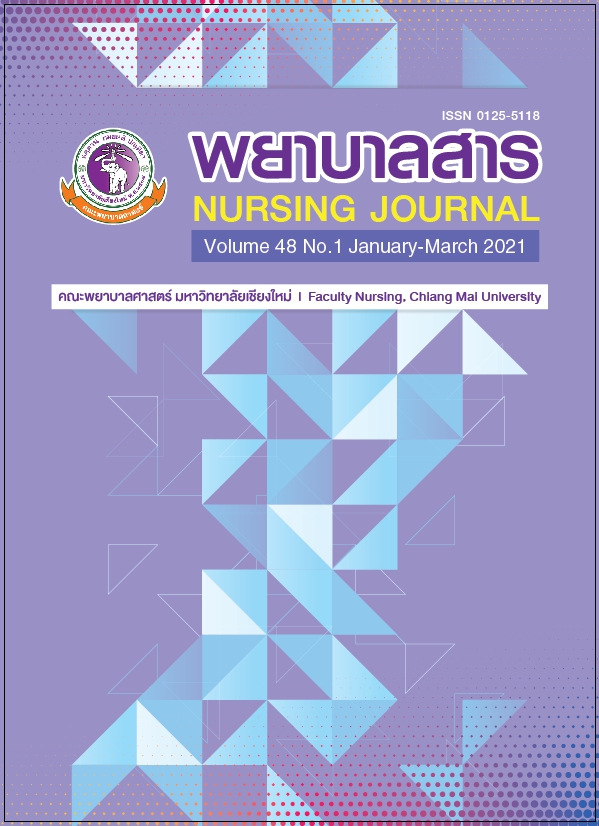Anxiety, Childbirth Experience and Childbirth Self-efficacy of Pregnant Women
Keywords:
anxiety, childbirth experience, childbirth self-efficacy, pregnant women, midwiferyAbstract
Childbirth self-efficacy is an important indicator of pregnant women’s ability to cope with labour and birth. The purpose of this descriptive correlational study was to explore the relationship between anxiety, childbirth experience and childbirth self-efficacy of pregnant women. Participants included eighty-five multigravid women with gestational age between 36-41 weeks who attended the antenatal clinic at Health Promoting Hospital, 1st Regional Health Promoting Center, Chiang Mai from May to August 2017. The research tools were the Thai Childbirth Self-Efficacy Inventory by Lowe (1993), the Thai version by Tanglakmankhong and others (2010), the State-Trait Anxiety Inventory form Y-1 by Spielberger (1976), the Thai version by Tatree Nontasak, Sompoch Iamsupasit, and Darawan Thapinta (1991) and the Perceived Childbirth Experience by Michels, Kruske and Thompson (2013), the Thai version by Chavee Baosoung and Nantaporn Sansiriphun (2017). Data were analyzed using descriptive statistics and Spearman’s rank correlation coefficient.
Result of the study revealed that:
- Participants had a mean score for anxiety of 41.34 (S.D. = 7.88), which was at a moderate level of anxiety.
- Participants had a mean score for childbirth experience of 4.09 (S.D. = .80), which was at a high level of positive childbirth experience.
- The mean score for total childbirth self-efficacy of participants was 232.59 (S.D. = 52.32), which was at a high level of childbirth self-efficacy. The participants’ mean score for self-efficacy expectancy was 115.78 (S.D. = 28.29) and for outcome expectancy was 116.81 (S.D. = 25.92). Both were at a high level of expectancy.
- Anxiety was negatively statistically significant associated with childbirth self-efficacy of pregnant women (r = -.42, p < .01).
- Childbirth experience was positively statistically significant associated with childbirth self-efficacy of pregnant women. (r = .50, p < .01).
The findings from this study can be used as baseline data for planning effective nursing care to promote childbirth self-efficacy of pregnant women.
References
Baosoung, C., & Sansiriphun, N. (2017). Perceived Childbirth Experience. Chiang Mai: Faculty of Nursing Chiang Mai University. (In Thai)
Beebe, K. R., Lee, K. A., Carrieri-Kohlman, V., & Humphreys, J. (2007). The effects of childbirth self-efficacy and anxiety during pregnancy on prehospitalization labor. Journal of Obstetric, Gynecologic, & Neonatal Nursing, 36(5), 410-418.
Bryanton. J., Gagnon, A. J., Johnston, C., & Hatem, M. (2008). Predictors of woman’s perceptions of the childbirth experience. Journal of Obstetric, Gynecologic, & Neonatal Nursing, 37(1), 24-34.
Butsangdee, B., Chareonsanti, J., & Kantaruksa, K. (2013). Effect of self-efficacy promotion on success in exclusive breastfeeding among cesarean section mothers. Nursing Journal, 40(3), 1-10. (In Thai)
Carlsson, I.-M., Ziegert, K., & Nissen, E. (2015). The relationship between childbirth self-efficacy and aspects of well-being, birth interventions and birth outcomes. Midwifery, 31(10), 1000-1007. doi:http://dx.doi.org/10.1016/j.midw.2015.05.005
Chaibarn, P., Kantaruksa, K., & Somboon, L. (2010). Effects of self-efficacy and social support enhancement intervention on exclusive breastfeeding behavior among first-time mothers. Nursing Journal, 37(4), 70-81. (In Thai)
Drummond, J., & Rickwood, D. (1997). Childbirth confidence: Validating the childbirth self-efficacy inventory (CBSEI) in an Australian sample. Journal of Advanced Nursing, 26. doi:10.1046/j.1365-2648.1997.t01-24-00999.x
Goodman, P., Mackey, M. C., & Tavakoli, A. S. (2004). Factors related to childbirth satisfaction. Journal of Advanced Nursing, 46(2), 212-219.
Hodnett, E. D. (2002). Pain and women's satisfaction with the experience of childbirth: A systematic review. American Journal of Obstetrics and Gynecology, 186(5), S160-S172.
Iamsupasit, S., Nontasak, T., & Thapinta, D. (1991). Reduction of anxiety of staff nurses working with aids patient through cognitive reconstructuring and mindfulness training. (Doctoral thesis, Department of Psychology, Chulalongkorn University). (In Thai)
Jokic, B. N., Zigic, L., & Nakic R. S. (2014). Anxiety and anxiety sensitivity as predictors of fear of childbirth: Different patterns for nulliparous and parous women. Journal of Psychosomatic Obstetrics & Gynecology, 35(1), 22-28.
Lowe, N. K. (1991). Maternal confidence in coping with labor: A self-efficacy concept. Journal of Obstetric Gynecologic & Neonatal Nursing, 20(6), 457-463.
Lowe, N. K. (1993). Maternal confidence for labor: Development of the childbirth self-efficacy inventory. Research in Nursing Health, 16, 141-149. doi:10.1002/nur.4770160209
Lowe, N. K. (2000). Self-efficacy for labor and childbirth fears in nulliparous pregnant women. Journal of Psychosomatic Obstetrics & Gynecology, 21(4), 219-224.
Lowe, N. K. (2002). The nature of labor pain. American Journal of Obstetrics and Gynecology, 186(5), S16-S24.
Manning, M. M., & Wright, T. L. (1983). Self-efficacy expectancies, outcome expectancies, and the persistence of pain control in childbirth. Journal of Personality and Social Psychology, 45(2), 421.
Marut, J. S., & Mercer, R. T. (1979). Comparison of primipara’s perceptions of vaginal and cesarean births. Nursing Research, 28(5), 260-266.
Michels, A., Kruske, S., Thompson. (2013). Women's postnatal psychological functioning: the role of satisfaction with intrapartum care and the birth experience. Journal of Reproductive and Infant Psychology, 31(2), 172-182. doi:10.1080/02646838.2013.791921
Nichols, F. H. (1992). The Psychological effects of prepared childbirth on single adolescent mothers. The Journal of Perinatal Education, 1(1), 41-49.
Polit, D. F. (2010). Statistics and data analysis for nursing research (2nd ed). New Jersey: Pearson Education Inc.
Salomonsson, B., Gullberg, M., Alehagen, S., & Wijma, K. (2013). Self-efficacy beliefs and fear of childbirth in nulliparous women. Journal of Psychosomatic Obstetrics & Gynecology, 34, 1-22. doi:10.3109/0167482x.2013.824418
Schwartz, L., Toohill, J., Creedy, D. K., Baird, K., Gamble, J., & Fenwick, J. (2015). Factors associated with childbirth self-efficacy in Australian childbearing women. BMC Pregnancy and Childbirth, 15(1), 1-9. doi:10.1186/s12884-015-0465-8
Shives, L. R. (2008). Basic concepts of psychiatric-mental health nursing (7thed.). Philadelphia: Lippincott.
Spielberger, C. D. (1976). The nature and measurement of anxiety. In C.D. Spielberger, & R.Diaz-Guerrero (Eds), Cross– cultural anxiety (pp. 3-12). Washington: Hemisphere.
Tanglakmankhong, K., Perri, N. A., & Lowe, N. K. (2010). Psychometric testing of the Thai version of the Childbirth Self-Efficacy Inventory and the Childbirth Attitudes Questionnaire. Unpublished manuscript, Portland.
Waldenstrom, U., Hildingsson, I., Rubertsson, C., & Radestad, I. (2004). A negative birth experience: Prevalence and risk factors in a national sample. Birth, 31(1), 17-27
Downloads
Published
How to Cite
Issue
Section
License
บทความที่ได้รับการตีพิมพ์เป็นลิขสิทธิ์ของวารสารพยาบาลสาร
ข้อความที่ปรากฏในบทความแต่ละเรื่องในวารสารวิชาการเล่มนี้เป็นความคิดเห็นส่วนตัวของผู้เขียนแต่ละท่านไม่เกี่ยวข้องกับมหาวิทยาลัยเชียงใหม่ และคณาจารย์ท่านอื่นๆในมหาวิทยาลัยฯ แต่อย่างใด ความรับผิดชอบองค์ประกอบทั้งหมดของบทความแต่ละเรื่องเป็นของผู้เขียนแต่ละท่าน หากมีความผิดพลาดใด ๆ ผู้เขียนแต่ละท่านจะรับผิดชอบบทความของตนเองแต่ผู้เดียว






